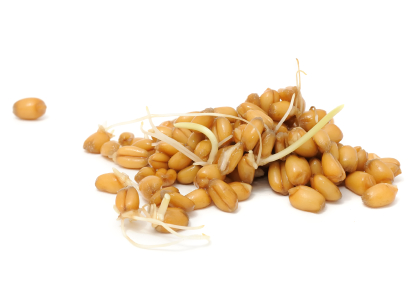I get a lot of questions about wheat and gluten. And although I go much deeper into this in my courses and programs, I thought I’d share a few of my thoughts here.
The following question was written in by a student in my Nourishment of the Soul program:
Q: Thanks for your 7-Day Meal Guide – I love it! I noticed you use whole wheat in your sourdough recipe, isn’t wheat bad for you? Leiba A. via e-mail
Dear Leiba,
I’m so happy you’re enjoying my 7-Day Meal Guide!
In my macrobiotic training, I studied the properties of grains extensively.
Wheat is considered one of the most mineral-dense grains, able to absorb a wider range of minerals from the soil than most any other grain in existence. It is also known to be the most nourishing grain for children, because according to Traditional Chinese Medicine and rooted in Kabbalah (we spoke about this in class), it’s considered an ideal food for human growth and development.
Wheat encourages growth on a physical, emotional, and spiritual level (we learn about this on Tu B’Shvat).
It is one of the very few foods attributed to directly calming and focusing the mind. And as one of the 7 blessings of the Land of Israel, wheat is characterized extensively in the Torah as a high-quality superfood loaded with nutrients for body, mind, and soul.
So what’s all the hoopla around wheat REALLY about?
There are three of factors causing confusion around this “miracle grain” from the Torah:
1) First, whole wheat goes rancid very quickly once it’s been ground into a flour. It should always be freshly-ground (you can do this using the high speed blender I recommended in the program’s Resource Rolodex). Rancid whole wheat flour can lead to wheat allergies and a host of other health problems (go back to Module 3 about oxidation). Many people who are allergic to processed-flour products can actually thrive on pre-soaked organic whole berries (cooked), sprouted wheat, and cultured sourdough.
2) Second, modern wheat hybrids tend to be higher in gluten than the traditional wheat hybrids (gluten is the protein in wheat, spelt, kamut, oats, rye, barley, and sweet rice, that can be somewhat difficult to digest). But you need to know that gluten is not “bad” at all.
In my macrobiotic training, we prepared “seitan” wheat-meat, and this is a prized protein-rich food throughout the East. Gluten isn’t a villain, but it does require sufficient digestion in order to be properly utilized as a protein without causing GI damage.
But in people with impaired digestion — most likely due to a lack of pancreatic enzymes and elevated stomach pH from thyroid hypofunctioning and a lifetime of stress, sugar, and refined, rancid foods — gluten can lead to digestive trouble.
It’s a “chicken-before-the-egg” scenario, where a poor digestive environment leads to an inability to adequately digest gluten – this then leads to a downward spiral of GI imbalance and intestinal permeability, which leads to gluten intolerance. The only way out of this vicious cycle is to repair the gut.
3) Third, overeating acid-forming foods such as processed dairy, antibiotic-laced meat and chicken, low-quality farmed fish, and refined grains grown with pesticides, can cause inflammation, GI damage, and subsequent food sensitivities to otherwise nutrient-dense foods. It is here in this category of grains that we find glyphosate.
It’s Glyphosate, Not Gliadin…
If you ask most people about glyphosate (Round Up), you’ll probably hear a couple of things: First, that it’s been proven to cause cancer. And second, that the only way to avoid it is to buy organic. However, use of this pesky organophosphate has grown exponentially in recent decades (together with a dramatic rise in autism, food sensitivities, and GI ailments). Despite the popularity of gluten-hatred in popular blogs and magazines, perhaps it’s time we realized the obvious – it’s not the gliadin in wheat that causes so many problems; it’s the glyphosate.
After all, for around 10,000 years wheat has been archaeologically documented in civilizations spanning the Fertile Crescent and North Africa (perhaps as Kamut or another early “original” wheat ancestor), and other grains such as corn, rice, and oats have been documented throughout the Americas, Asia, Europe, and everywhere in between. It’s undisputed that populations not only survived on wheat and other grains, but that they THRIVED.
As a student of anthropology at UCLA, I learned that along with the introduction of farming and grains came written language and virtually every other aspect of modern society as we know it. Of course, wheat, oats, barley, and corn couldn’t have singlehandedly formed the basis of intellectual and sociocultural growth. But it cannot be disputed that these things did go hand-in-hand, and the post-grain sociocultural growth persisted at a staggering pace.
Aside from gliadin (gluten), lectins are often called out by functional nutritionists as one of the most detrimental food elements to our microbiome, and I agree to a certain extent. (I’ve seen dramatic improvements in some clients when we restriced lectins, and I’ve been teaching classes on “the art of sprouting and culturing” for years now (following my macrobiotic training in 1991-92), and I truly believe that traditional cultures soaked, sprouted, and cultured their grains and legumes – perhaps intuitively – as a way to reduce lectins and other anti-nutrients.
But even if soaking/sprouting/culturing is skipped, the following must be noted and highlighted:
Lectins don’t even come close to the trainwreck that is glyphosate.
Roundup-Ready wheat and corn are perhaps the greatest scourges to our health that have ever existed, and these two so-called “grains” are what make up the majority of our Standard American Diet (SAD) – especially the SADs of our children.
Glyphosate disrupts the “shikimate bacterial pathway” within the GI tract, altering the balance between pathogens and beneficial biota, chelating transition metals, sulfur, and selenium, and inhibiting many of the phase-two liver detoxifying cytochrome P450 enzymes.
It’s important to note that as humans, our physiology is not merely the 20-25,000 genes that have been discovered in the Human Genome Project, but that we are actually outnumbered by bacteria. As such, anything that disrupts the shikimate bacterial pathway directly disrupts us on many levels — physiological, emotional, and more.
Disruptions in the shikimate bacterial pathway will eventually cause malfunctioning within our GI microbiome and therefore, will dramatically impair the conversion of tyrosine, phenylalanine, and tryptophan. Among other things, these three amino acids are converted into thyroid hormone, dopamine, and serotonin, respectively.
Perhaps this could explain the three-pronged epidemic of depression, anxiety, and thyroid dysregulation in this country? Or the epidemic of GI disorders and autism?
The traditional wheat described in the Torah was most likely Kamut.
Like all wheat, kamut (Triticum polonicum) is a glutenous grain. But in some tests, approximately two-thirds of those with wheat allergy had less or no allergy to kamut.
Two other glutenous grains that seem to be well-tolerated in gluten-sensitive individuals are spelt and oats. These grains do contain gluten, but as in the case of kamut, the structure of the grain seems to be more tolerable by allergy-prone individuals.
Sweet rice, rye, barley, and modern “whole wheat” contain substantial quantities of gluten and tend to cause problems in gluten-sensitive individuals – soaking, sprouting, and/or culturing the grain before preparation may reduce or even remove intolerances completely.
Celiacs and others with gluten intolerance should test for reactions with very small portions, and should first focus on healing the GI tract and building immunity before introducing glutenous grains to the diet.
There are a number of clinically proven methods for restoring intestinal permeability and thus reducing or eliminating gluten sensitivity. In my practice, I do not employ one method for everyone. However, most methods incorporate some version of the Institute for Functional Medicine’s “5 R” Framework, which is the primary method that I was taught in graduate school, utilizing therapeutic diets together with potent herbal and nutraceutical treatments. Occassionally, pharmaceutical treatments are used as well.
Another method utilizes a three-phase approach: re-soil, re-seed, and re-feed. Phase three is individualized and requires the assistance of a licensed nutrition professional, but phases one (progressive reduction) and two (elimination diet) can be accomplished by oneself at home.
A number of anti-inflammatory medical nutrition therapy protocols can be used to decrease intestinal permeability and strengthen the tight junctions of the GI tract, depending on the client. These might include the specific carbohydrate diet (SCD), the macrobiotic diet, the raw foods diet, the low-FODMAPS diet, 16/8 intermittent fasting 8 PM to 12 PM, or an individualized autoimmune protocol that also incorporates lifestyle change.
No matter which medical nutrition protocol is used, sulfur/cruciferous foods should always be incorporated, as these are the most potent DNA-protective anti-cancer foods, and we live in an increasingly toxic world. In addition, prebiotic foods such as garlic, onions, flax seeds, chicory, and berries, should be emphasized just as much — if not even more — than fermented, probiotic foods. Without tight junction dysregulation and intestinal permeability, one should be able to enjoy these foods without any trouble; with dysregulation, we cycle them in gradually. And the Environmental Working Group’s “Dirty Dozen and Clean 15” should always be considered, with the caveat that it’s better to eat a nonorganic veggie from the Dirty Dozen than no veggies at all!
Perhaps most importantly, diversity is key. As explained in my book, Kosher for Life: A Seasonal Guide to Cooking the Jewish Way, in order to enhance the diversity, balance, and resilience of the microbiome — along with the emotions and physiology — eating according to the seasons is perhaps the most powerful nutritional therapy of all.




